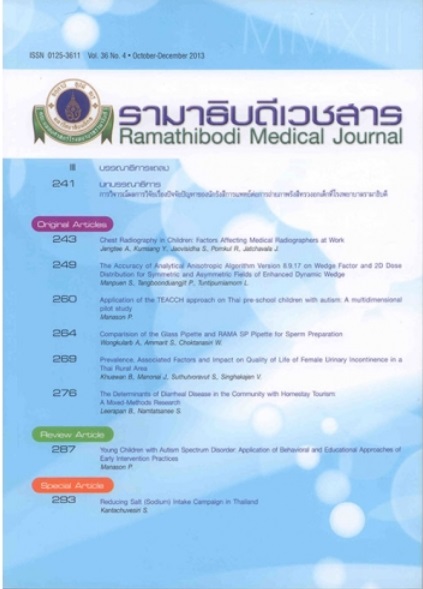The Accuracy of Analytical Anisotropic Algorithm Version 8.9.17 on Wedge Factor and 2D Dose Distribution for Symmetric and Asymmetric Fields of Enhanced Dynamic Wedge
Main Article Content
Abstract
Background: The technique of Enhanced Dynamic Wedge (EDW) was introduced to establish the wedge shape dose distribution. Prior to the application in clinical situations was required the verification of dose calculation to reproduce the EDW in treatment planning system (TPS).
Objective: To evaluate the accuracy of Anisotropic Analytical Algorithm (AAA) version 8.9.17 for the EDW in symmetric and asymmetric fields.
Methods: Comparison between measured and calculated Enhanced Dynamic Wedge Factors (EDWFs) and 2D dose distributions were investigated for 6 MV photon beam of 10o, 30o, and 60o EDW non field size 10x10 cm2, 15x15 cm2 and 20x20 cm2 for symmetric and asymmetric fields in wedge and non-wedge direction. The points of evaluation for EDWF were the central and off-axis for each situation.
Results: The percentage deviation between measured and calculated EDWFs was less than 1% for all geometries, both symmetric and asymmetric of EDW field. For the off-axis points, the maximum deviation was 1.22% for asymmetric field Y2 = 0 (in wedge direction) of field size 10x10 cm2 for EDW 60o. The comparison of 2D dose distributions using MapCHECK2 showed good agreement between measured and calculated with the AAA algorithm with a 100% passing rate for nearly all geometries of EDW fields. The minimum passing rate found in asymmetric field size 20x20 cm2 (X1 = 0 and Y2 = 0) of EDW 10o was 94.9%.
Conclusions: The results of this study confirm the accuracy of the AAA calculations in modeling the enhanced dynamic wedge both symmetric and asymmetric fields.
Article Details
References
Varian Oncology System C-Series. Clinic Enhanced Dynamic Wedge Implementation Guide; January 2002.
Leavitt DD, Martin M, Moeller JH, Lee WL. Dynamic wedge field techniques through computer-controlled collimator motion and dose delivery. Med Phys. 1990;17(1):87-91.
Salomons GJ, Kerr AT, Mei X, Patel D. The accuracy of MU calculations for dynamic wedge with the Varian's Anisotropic Analytical Algorithm. Med Phys. 2008;35(10):4289-4291.
Ahmad M, Hussain A, Muhammad W, Rizvi SQ, Matiullah. Studying wedge factors and beam profiles for physical and enhanced dynamic wedges. J Med Phys. 2010;35(1):33-41. doi:10.4103/0971-6203.57116.
Salk J, Blank P, Machold U, Rau E, Schneider E, Röttinger EM. Physical aspects in the clinical implementation of the Enhanced Dynamic Wedge (EDW). Proceedings of the 8th Varian European Users Meeting; 1997:27-30; Vilamoura, Algarve-Portugal.
Shao H, Wu X, Luo C, Crooks S, Bernstein A, Markoe A. The accuracy of dynamic wedge dose computation in the. ADAC Pinnacle RTP system. J Appl Clin Med Phys. 2001;5:46-54.
Anjum M, Qadir A, Afzal M. Dosimetric evaluation of a treatment planning system using pencil beam convolution algorithm for enhanced dynamic wedges with symmetric and asymmetric fields. Int J Radiat Res. 2008;5(4):169-174.
Venselaar J, Welleweerd H, Mijnheer B. Tolerances for the accuracy of photon beam dose calculations of treatment planning systems. Radiother Oncol. 2001;60(2):191-201.
Caprile PF, Venencia CD, Besa P. Comparison between measured and calculated dynamic wedge dose distributions using the anisotropic analytic algorithm and pencil-beam convolution. J Appl Clin Med Phys. 2006;8(1):47-54.
Christopher MB, Conway J. Dosimetric verification of the anisotropic analytical algorithm for radiotherapy treatment planning. J Eur Soc Therap Radiol Oncol. 2006;81:315-323.
Prasad SC, Bassano DA. Corner transmission in several linear accelerator photon beams. Med Phys. 1991;18(4):763-764.
Fraass B, Doppke K, Hunt M, et al. American Association of Physicists in Medicine Radiation Therapy Committee Task Group 53: quality assurance for clinical radiotherapy treatment planning. Med Phys. 1998;25(10):1773-1829.
Gibbons JP. Calculation of enhanced dynamic wedge factors for symmetric and asymmetric photon fields. Med Phys. 1998;25(8):1411-1418.
Jydon JM, Rykers KL. Beam profiles in the nonwedged direction for dynamic wedges. Med Phys Biol. 1996;41:1217-1225.
Zhu J. Generation of wedge-shaped dose distributions through dynamic multileaf collimator dose delivery. J Appl Clin Med Phys. 2005;6(3):37-45.
Létourneau D, Gulam M, Yan D, Oldham M, Wong JW. Evaluation of a 2D diode array for IMRT quality assurance. Radiother Oncol. 2004;70(2):199-206.
Childress NL, Dong L, Rosen II. Rapid radiographic film calibration for IMRT verification using automated MLC fields. Med Phys. 2002;29(10):2384-2390.
Oh M. Dosimetric comparison of a semi-conductor array (MapCheck), EDR2 film and ion-chamber in the commissioning of Enhanced Dynamic Wedges on a Varian Linear Accelerator (21 EX). Med Phys. 2006;33:2090.
